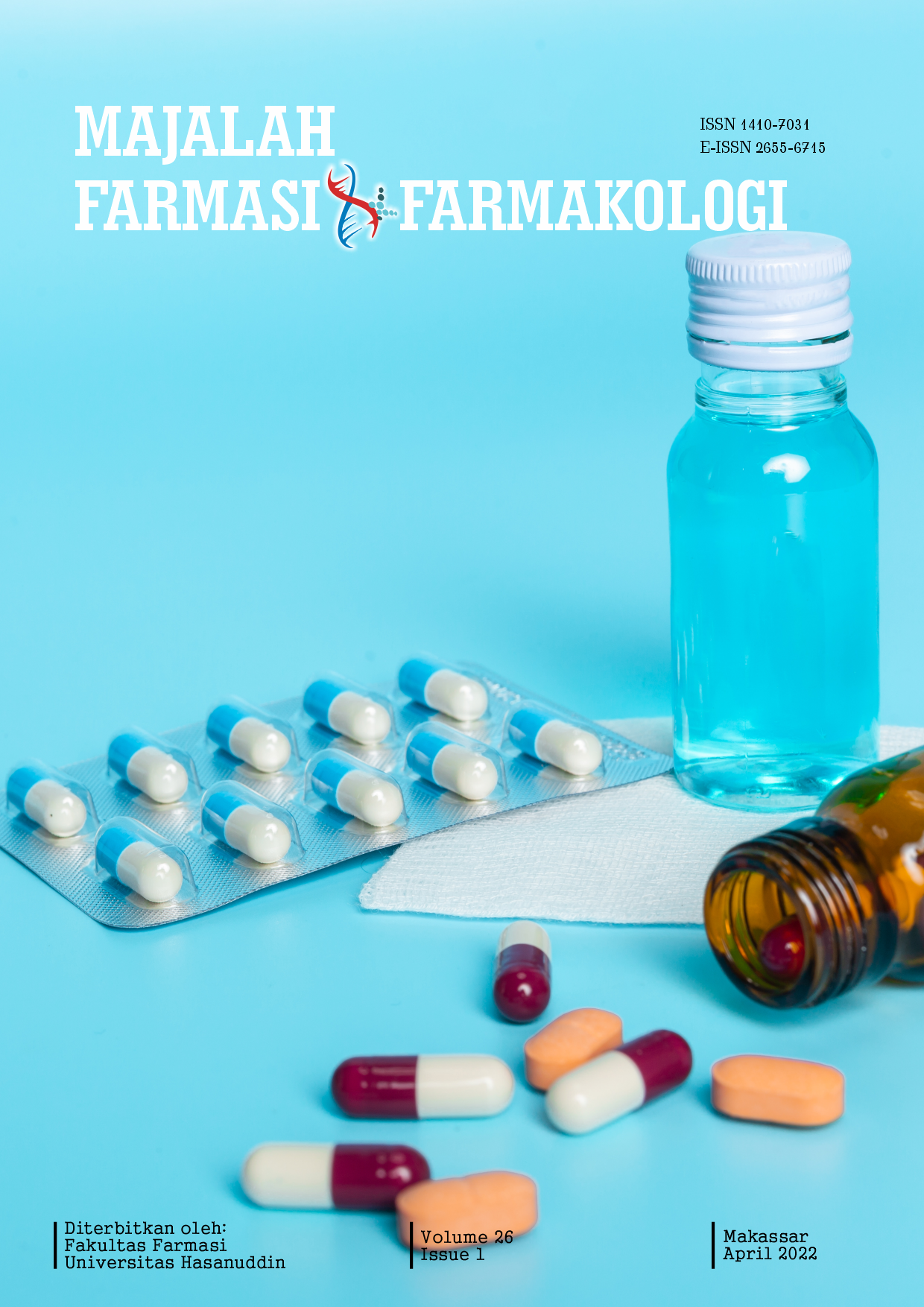KARAKTERISTIK PASIEN TUBERKULOSIS PARU DI PUSKESMAS KOTA BAUBAU SULAWESI TENGGARA
Keywords:
Tuberkulosis, Perbandingan, Dalam Kota, Pinggiran Kota, Karakteristik pasien, Tuberkulosis Paru, Puskesmas, Kota BaubauAbstract
Tuberkulosis (TB) adalah salah satu penyakit infeksi menular melalui udara yang paling mematikan. Penyakit TB disebabkan terutama oleh bakteri patogen Mycobacterium tuberculosis (Mtb ). Penelitian ini bertujuan untuk mengetahui karakteristik pasien sebagai data pendukung untuk evaluasi tatalaksana terapi pada pasien TB paru. Penelitian ini merupakan penelitian deskriptif yang dilakukan di Puskesmas Kota Baubau Sulawesi Tenggara sejak Desember 2020-Februari 2021. Sampel Penelitian berjumlah 49 orang. Pengumpulan data dilakukan dengan bersumber dari data rekam medis, SITB (Sistem Informasi Tuberkulosis) dan kuesioner. Data penelitian kemudian dianalisis dengan menggunakan uji statistik SPSS. Hasil penelitian berupa data karakteristik pasien tuberkulosis paru di Puskesmas kota Baubau yang menunjukkan bahwa pasien tuberkulosis paru terbanyak pada jenis kelamin laki-laki (65,3%), umur 15-35 tahun (65,3%), pendidikan dasar dan menengah (73,5%), pekerjaan wiraswasta (51%), penghasilan >Rp 500.000 (75,5%), pemeriksaan akhir bulan ke enam BTA(-) (95,9%), pasien BTA(+) (4,1%), kepatuhan pasien (89,8%), pengetahuan responden tinggi (51%), efek samping obat terbanyak badan lemas (28,6%), mual (28,6%). Sebanyak (26,53%) pasien dengan penyakit penyerta dan 14,29% dengan keluhan gangguan asam lambung telah menerima Antasida.
References
Ansumana, R dkk. 2017. Impact Of Infectious Disease Epidemics On Tuberculosis Diagnostic, Management, And Prevention Services: Experiences And Lessons From The 2014-2015 Ebola Virus Disease Outbreak In West Africa. Int. J. Infect. Dis. 56, 101.
WHO. 2019. Global Tuberculosis Report. World Health Organization. Geneva.
Dinkes, 2018. Profil Kesehatan Provinsi Sulawesi Tenggara Tahun 2017. Data dan Informasi Dinas Kesehatan Provinsi Sulawesi Tenggara. Kendari.
Dinkes. 2020. Profil Kesehatan Kota Baubau Tahun 2019. Dinas Kesehatan Kota Baubau. Baubau.
Narasimhan P, Wood J, Macintyre CR, Mathai D. 2013. Risk factors for tuberculosis. Pulm Med. 2013:828939.
Dogar, O. F., Shah, S. K., Chughtai, A. A., et al. 2012. Gender disparity in tuberculosis cases in eastern and western provinces of Pakistan. BMC Infectious Diseases. vol. 12, article 244.
Severo, N. P., Leite, C. Q., Capela, M. V., et al. 2007. Clinical and demographic characteristics of patients hospitalized with tuberculosis in Brazil between 1994 and 2004. Jornal Brasileiro de Pneumologia, vol. 33, no. 5, pp. 565–571.
Miller TL, McNabb SJ, Hilsenrath P, et al. 2009. Personal and societal health quality lost to tuberculosis. PLoS One. 4:e5080.
Madan J, Lönnroth K, Laokri S, et al. 2015. What can dissaving tell us about catastrophic costs? linear and logistic regression analysis of the relationship between patient costs and financial coping strategies adopted by tuberculosis patients in Bangladesh, Tanzania and Bangalore, India. BMC Health Serv Res. 15:476.
WHO. 2013. Global TB Report. WHO Library Cataloguingin-Publication Data. 1. Tuberculosis Epidemiology. 2. Tuberculosis, Pulmonary-prevention and control. 3.Tuberculosis - economic. 4.Tuberculosis Multidrug Resistant, 5. Annual Report. I. World Health Organization. Geneva. ISBN 9789241564656.
Carla, L., Oliveira, S., De Almeida Nogueira, J., Duarte De Sá, L., Palha, P. F., Alves Da Silva, C., Villa, S. 2015. The discourse of individuals on feelings associated with coping with tuberculosis* A discursividade do sujeito sobre sentimentos associados ao enfrentamento da tuberculose. Revista Eletrônica de Enfermagem. 17(1).
Alobu I, Oshi SN, Oshi DC, Ukwaja KN. 2014. Risk factors of treatment default and death among tuberculosis patients in a resource-limited setting. Asian Pacific J Trop Med. 7(12):977-84.
Fatiregun AA, Ojo AS, Bamgboye AE. 2009. Treatment outcomes among pulmonary tuberculosis patients at treatment centres in Ibadan, Nigeria. Annals of African Med. 8(2).
Kemkes. 2017. Pengobatan Pasien Tuberkulosis. Direktoral Jenderal Pencegahan dan Pengendalian Penyakit. Jakarta.
Harries AD, Zachariah R, Corbett EL, Lawn SD, Santos-Filho ET, Chimzizi R et al. 2010. The HIV-associated tuberculosis epidemic – when will we act? Lancet. 375:1906–19.
Lonnroth K, Roglic G, Harries AD. 2014. Improving tuberculosis prevention and care through addressing the global diabetes epidemic: from evidence to policy and practice. Lancet Diabetes Endocrinol. 2:730–9.
Sbrana E, Grise J, Stout C, Aronson J. 2011. Co-morbidities associated with tuberculosis in an autopsy case series. Tuberculosis. 91: S38–S42.
Rainsford KD, Bjarnason I. 2012. NSAIDs: take with food or after fasting? J Pharm Pharmacol. 64:465–9.
Saktiawati AM, Sturkenboom MG, Stienstra Y, et al. 2016. Impact of food on the pharmacokinetics of first-line anti-TB drugs in treatment-naive TB patients: a randomized cross-over trial. J Antimicrob Chemother. 71:703–10.
Boulle A, Van Cutsem G, Cohen K, et al. 2008. Outcomes of nevirapine- and efavirenz-based antiretroviral therapy when coadministered with rifampicin-based antitubercular therapy. JAMA. 300:530-9.
Brennan-Benson P, Lyus R, Harrison T, Pakianathan M, Macallan D. 2005. Pharmacokinetic interactions between efavirenz and rifampicin in the treatment of HIV and tuberculosis: one size does not fit all. AIDS. 19:1541–3.
Sun H, Scott DO. 2011. Impact of genetic polymorphisms of cytochrome P450 2 C (CYP2C) enzymes on the drug metabolism and design of antidiabetics. Chem Biol Interact. 194:159–167.
Hofmann-Thiel S, Van Ingen J, Feldmann K, Turaev L, Uzakova GT, et al. 2009. Mechanisms of heteroresistance to isoniazid and rifampin of Mycobacterium tuberculosis in Tashkent, Uzbekistan. Eur Respir J. 33: 368-374.
Vashisht R, Brahmachari SK. 2015. Metformin as a potential combination therapy with existing front-line antibiotics for Tuberculosis. J Transl Med. 13: 83.
Singhal A, Jie L, Kumar P, Hong GS, Leow MK, et al. 2014. Metformin as adjunct antituberculosis therapy. Sci Transl Med. 6: 263ra159.
Caminero Luna JA. 2003. Guía de la Tuberculosis para Médicos Especialistas. Unión Internacional Contra la Tuberculosis y Enfermedades Respiratorias. Paris.
Baxter, Editor. 2008. Stockley’s Drug Interactions. Eighth Edition. Pharmaceutical Press halaman 2, 9-11. London.
Shargel, L., Yu, A., and Wu, S. 2005. Biofarmastika dan Farmakokinetika Terapan Edisi Kedua. Airlangga University Press. Surabaya.
Hennessy E, Adams C, Reen FJ, O’Gara F. 2016. Is there potential for repurposing statins as novel antimicrobials? Antimicrob Agents Chemother. 60:5111–5121.
Schaller, A., Z. Sun, Y. Yang, A. Somoskovi, and Y. Zhang. 2002. Salicylate reduces susceptibility of Mycobacterium tuberculosis to multiple antituberculosis drugs. Antimicrob. Agents Chemother. 46:2636–2639.
WHO. 2018. Global Tuberculosis Report. World Health Organization. Geneva.
Downloads
Published
Issue
Section
License
Copyright (c) 2022 Majalah Farmasi dan Farmakologi

This work is licensed under a Creative Commons Attribution-NonCommercial 4.0 International License.
The copyright to this article is transferred to Universitas Hasanuddin (UNHAS) if and when the article is accepted for publication. The undersigned hereby transfers all rights in and to the paper including without limitation all copyrights to UNHAS. The undersigned hereby represents and warrants that the paper is original and that he/she is the author of the paper, except for material that is clearly identified as to its original source, with permission notices from the copyright owners where required. The undersigned represents that he/she has the power and authority to make and execute this assignment.
We declare that:
- This paper has not been published in the same form elsewhere.
- It will not be submitted anywhere else for publication prior to acceptance/rejection by this Journal.
- A copyright permission is obtained for materials published elsewhere and which require this permission for reproduction.
Furthermore, I/We hereby transfer the unlimited rights of publication of the above-mentioned paper in whole to UNHAS The copyright transfer covers the exclusive right to reproduce and distribute the article, including reprints, translations, photographic reproductions, microform, electronic form (offline, online) or any other reproductions of similar nature.
The corresponding author signs for and accepts responsibility for releasing this material on behalf of any and all co-authors. This agreement is to be signed by at least one of the authors who have obtained the assent of the co-author(s) where applicable. After submission of this agreement signed by the corresponding author, changes of authorship or in the order of the authors listed will not be accepted.


